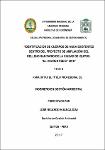Identificación de cuerpos de agua existentes dentro del proyecto de ampliación del relleno sanitario de la ciudad de Iquitos. "El Cuarentiseis" 2016.
Abstract
El área de estudio se encuentra ubicada en el distrito de San Juan Bautista, provincia de Maynas, región de Loreto, en el sector denominado PARCELACION EL TRIUNFO III ETAPA - PARCELA Nº 117, a la altura del kilómetro 46 de la carretera Iquitos-Nauta (margen derecha). Teniendo como limites principales Por el Norte: Con la comunidad 10 de octubre, Por el Sur: Con la Ciudad de Nauta.
El objetivo del estudio fue identificar los cuerpos de agua dentro y fuera de la zona proyectada para la construcción del relleno sanitario de la ciudad de Iquitos, localizado en el kilómetro 46 de la carretera Iquitos – nauta.
De acuerdo a los resultados de la investigación, se puede afirmar que el relieve del terreno proyectado para el relleno sanitario de la ciudad de Iquitos localizado en el k 46 de la carretera Iquitos-Nauta presenta una topografía accidentada con predominancia de colinas alargadas, que son cortadas por pequeñas quebradas de poco desarrollo, bajiales, y humedales cuyas aguas toman el curso de las "quebradas" de la zona, que posteriormente desembocan en el río Itaya. Estos ambientes acuáticos son de baja productividad, ligeramente alterados por la actividad humana.
Se ha identificado 50 cuerpos de agua, de las cuales 2 quebradas son principales que cruzan el área de estudio con dirección suroeste, donde Q1 tiene un recorrido de 350 m y Q14 un recorrido de 205 m en el área de terreno para el futuro relleno sanitario, también 8 quebradas de ojo de agua, en la que cada quebrada tiene el siguiente recorrido dentro del terreno Q12 = 218 m ,Q16= 300m ,Q2=120m, Q3= 103m, Q4=90m, Q5=97m, Q9=17m, Q91=12m y 40 quebradas secas que solo se activan durante las precipitaciones en el área.
El área del proyecto del futuro relleno sanitario se caracteriza por tener especies forestales de alto valor económico, donde se pueden apreciar especies útiles entre maderables, para construcción, comestibles, medicinales, y ornamentales. Así mismo especie de fauna.
La etapa con mayor problema estaría identificada en la de construcción y operación del relleno sanitario, principalmente en el área donde se encuentran las dos quebradas debido a que estas se verán desviadas de su curso normal, por la construcción de la Trinchera Nº 1, convirtiéndose en un área propensa a las inundaciones por escorrentía superficial, y por ende dichos cuerpos de agua estarían sujetos a contaminación. Contraviniendo a los criterios para la selección de áreas de infraestructuras de residuos sólidos. Ley 27314, Ley General de Residuos Sólidos (2004). The study area is located in the district of San Juan Bautista, province of Maynas, region of Loreto, in the sector called PARCELACION EL TRIUNFO III ETAPA - PARCELA Nº 117, at kilometer 46 of the Iquitos-Nauta road ( Right margin). Leading as the main boundaries North: With the community October 10, South: With the City of Nauta.
The objective of the study was to identify the water bodies inside and outside the projected area for the construction of the sanitary landfill of the city of Iquitos, located at kilometer 46 of the Iquitos - nauta highway.
According to the results of the investigation, it is possible to affirm that the relief of the projected land for the sanitary landfill of the city of Iquitos located in the k 46 of the highway Iquitos-Nauta presents a rugged topography with predominance of elongated hills, that are Cut by small ravines of low development, basins, and wetlands whose waters take the course of the "gullies" of the area, which later flow into the Itaya River. These aquatic environments are low productivity, slightly altered by human activity.
It has been identified 50 bodies of water, of which 2 main streams cross the study area with southwest direction, where Q1 has a course of 350 m and Q14 a course of 205 m in the area of land for the future landfill, Also 8 water-hole gullies, where each gully has the following course within the terrain Q12 = 218 m, Q16 = 300m, Q2 = 120m, Q3 = 103m, Q4 = 90m, Q5 = 97m, Q9 = 17m, Q91 = 12m and 40 dry ravines that only activate during the rainfall in the area.
The project area of the future sanitary landfill is characterized by forest species of high economic value, where you can appreciate useful species among timber, for construction, edible, medicinal, and ornamental. Likewise species of fauna.
The stage with the greatest problem would be identified in the construction and operation of the sanitary landfill, mainly in the area where the two streams are located because they will be diverted from their normal course by the construction of Trinchera No. 1, becoming An area prone to surface runoff flooding, and therefore such bodies of water would be subject to contamination. Contrary to the criteria for the selection of areas of solid waste infrastructure. Law 27314, General Law on Solid Waste (2004).
Collections
- Tesis [506]
The following license files are associated with this item:


